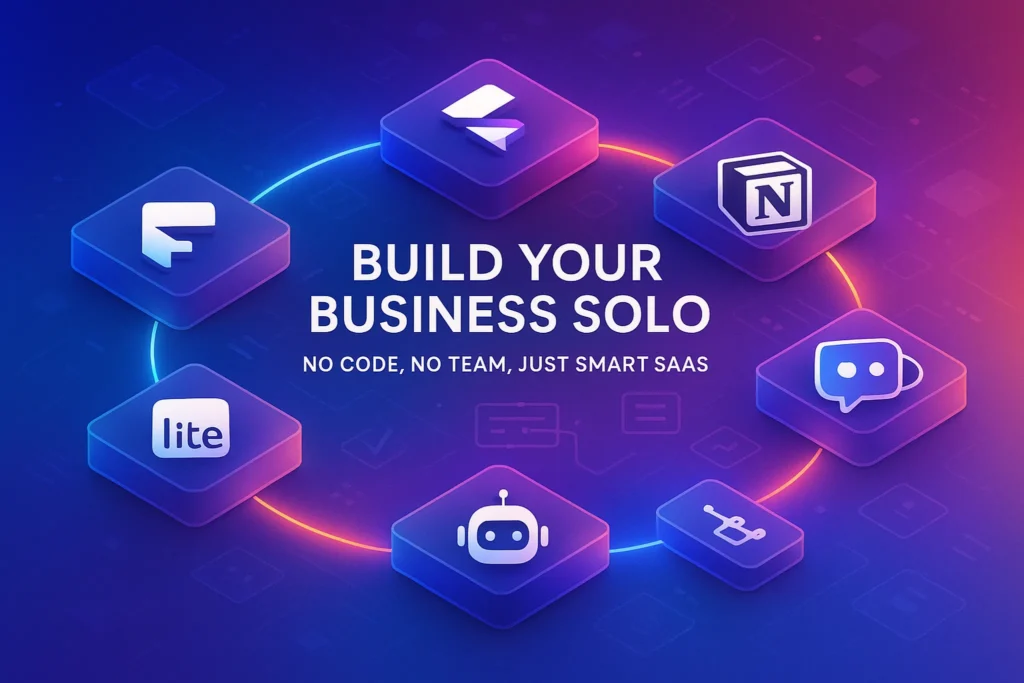-This post may contain affiliate links. If you click on one and make a purchase, I may earn a small commission at no extra cost to you.-
🧠 Introduction – The Nerd Philosophy
Let’s say your website, tools, team—all gone.
It’s just you, an internet connection, and $100 to rebuild.
What would you start with?
These aren’t just tools I like—they’re tools I’d bet on if I had to rebuild my business from scratch. Lightweight, scalable, solo-friendly, and battle-tested.
Here’s the exact SaaS stack I’d choose—and why.
🛠️ 1. Framer – For Instant Site Launching
Extended Use Case:
Imagine launching a one-page landing site for your new AI course. You pick a Framer template, write 3 headlines with GPT, and hit publish—all in 2 hours. You connect it to MailerLite and Stripe. Now you’re collecting leads and payments tonight.
Compared To:
Squarespace and Webflow are polished—but slower to learn. Framer gives you startup-grade speed with design-level freedom, perfect for MVPs or first launches.
Why It’s Essential:
Framer lets you go from “idea” to “launchable website” in hours—not days. With pre-built templates, animations, and AI-assisted layout tools, you can ship a professional homepage without writing code.
Use Case:
Launching a landing page for your newsletter, portfolio, SaaS, or AI tool? Framer’s real-time editor + mobile responsiveness makes it perfect for MVPs.
Features:
-
Drag & drop UI + custom sections
-
Built-in analytics + SEO
-
AI-assisted content generation
-
Fast publishing (custom domains)
Why Not WordPress?
Too heavy, too messy, too 2015. Framer is built for speed and iteration.
🧠 Nerd Verdict: “If you can write a tweet, you can build a Framer site.”
✉️ 2. MailerLite – Email Marketing Made Simple
Extended Use Case:
You grow your email list from 0 to 500 using a Framer pop-up → MailerLite automatically sends a 4-email onboarding sequence. Later, you segment users by click behavior and send targeted follow-ups about a product launch.
Compared To:
ConvertKit is great for creators, but pricier and less beginner-friendly. Mailchimp’s UI still confuses beginners. MailerLite balances power + simplicity perfectly for new founders.
Why It’s Essential:
When you’re starting from scratch, you need to build an audience—fast. MailerLite offers automation, landing pages, and newsletters in one clean, beginner-friendly platform.
Use Case:
You set up a Framer landing page → connect MailerLite form → start growing your list with lead magnets, then set up automated welcome emails.
Features:
-
Free plan up to 1,000 subscribers
-
Email automations (drip sequences, welcome flows)
-
Landing pages + pop-ups
-
Drag-and-drop email editor
Why Not ConvertKit?
Great tool, but MailerLite gives 90% of the same power at a better entry price—ideal when you’re rebuilding on a budget.
🧠 Nerd Verdict: “No list, no business. MailerLite helps you start building both.”
🔗 3. Tally + Make – Automate Everything Early
Extended Use Case:
Someone fills a client onboarding form in Tally → Make creates a Notion page with project info, triggers a payment email via Stripe, and schedules a Calendly call. You just sipped coffee while this happened.
Compared To:
Typeform looks great but limits usage on free plans. Zapier’s more popular than Make, but Make is visual, more generous, and easier to debug.
Why It’s Essential:
In the early days, you are the operations team. Tally lets you collect data (leads, surveys, orders), and Make connects it to everything—no code needed.
Use Case:
Someone fills your onboarding form → Make auto-adds them to Notion CRM + triggers a welcome email in MailerLite + sends you a Slack alert. You didn’t lift a finger.
Features:
-
Unlimited forms with conditional logic (Tally)
-
1,000s of app integrations (Make)
-
Easy visual automation builder
-
Works with Stripe, Notion, Airtable, Gmail
Why Not Zapier?
Zapier’s powerful, but Make gives more flexibility (and better free tier) for startups bootstrapping on $0.
🧠 Nerd Verdict: “Collect → Connect → Automate. That’s the solo founder’s magic loop.”
💬 4. Chatbase – Instant AI Chatbot for Your Business
Extended Use Case:
A user hits your pricing page at 11pm. They ask, “Does this tool integrate with Zapier?” Your Chatbase bot trained on your help docs replies instantly with a smart, human-like answer—keeping the lead hot while you sleep.
Compared To:
Tidio is great for ecommerce. Intercom is powerful but too heavy for a solo founder. Chatbase hits the sweet spot of function and simplicity.
Why It’s Essential:
Support is crucial—even with no team. Chatbase lets you train a GPT-powered chatbot on your content (website, docs, FAQs) and embed it in minutes.
Use Case:
Launching a SaaS product? Train Chatbase on your knowledge base or Notion docs → embed on site → customers get 24/7 support instantly.
Features:
-
Train bots from URLs, PDFs, or raw text
-
GPT-powered, brand-tone friendly
-
Custom widgets + embed code
-
Supports file upload, API access, analytics
Why Not Intercom or Drift?
Too bulky, expensive, and overkill for early-stage. Chatbase gives you smart AI support without overhead.
🧠 Nerd Verdict: “Sleep like you’ve got a 3-person support team.”
📈 5. Notion – The OS for Your One-Person Business
Extended Use Case:
You track leads, set deadlines, manage project status, and build client portals—all in one workspace. You even store swipe files, content ideas, and business SOPs. Notion’s AI helps draft emails, summarize meetings, and polish proposals.
Compared To:
Airtable is database-first. Trello is task-first. Notion merges both—and adds AI. Perfect when you’re building alone but thinking long-term.
Why It’s Essential:
No tool adapts faster to your evolving workflow than Notion. In the early days, it’s your CRM, task manager, SOP doc, and even client portal—all in one.
Use Case:
You create a client tracker, weekly planner, meeting notes, and SOP library—all using AI-enhanced templates. It’s your second brain on day one.
Features:
-
Infinite customization (databases, templates, relations)
-
Built-in Notion AI for summarizing, generating, editing
-
Shareable pages (for clients, docs, forms)
-
Works great solo or when scaling up to a team
Why Not Google Docs + Sheets?
Disorganized, scattered, and unscalable. Notion lets you centralize your operations with structure.
🧠 Nerd Verdict: “Your workspace, task manager, and business memory—merged.”
🔒 Why This Stack Works for Solo Founders
The power of this 5-tool stack lies in synergy. Each tool solves a key part of solo building:
-
Framer: Public face of your brand
-
MailerLite: Core of your relationship engine
-
Tally + Make: Your operations manager
-
Chatbase: 24/7 support team
-
Notion: Command center for everything
There’s no fluff. No unnecessary subscriptions. Every tool talks to the next, creating a fully-functioning business loop.
🧠 Nerd Verdict: “If you’re building solo in 2025, this is your unfair stack.”
📊 All Tools at a Glance – My Rebuild Stack
| Tool | Core Role | Why I’d Pick It | Affiliate? |
|---|---|---|---|
| Framer | Website builder | Fast, modern, no-code publishing | ✅ Yes |
| MailerLite | Email marketing | Powerful free tier + automations | ✅ Yes |
| Tally + Make | Data + automation | Simplifies backend with no code | ✅ Yes |
| Chatbase | AI chatbot support | Instant customer help, no team | ✅ Yes |
| Notion | All-in-one workspace | Run ops, CRM, docs in one place | ✅ Yes |
💡 Pro Tips for Starting Solo with SaaS
-
🧠 Choose Tools That Talk to Each Other: Notion + Make + Tally = fully connected without APIs.
-
⚙️ Automate Early: Every repeatable task can be offloaded with the right stack—even if it’s just one client a week.
-
💬 Own Your Support: Chatbots like Chatbase make even a 1-person team feel like a 24/7 agency.
🧠 Nerd Verdict: “This stack isn’t theory—it’s tested, minimal, and scales when you do.”
❓ FAQ – For Bootstrappers + Solo Builders
Can I build a business with just these tools?
Yes. This exact stack covers website, email, automation, CRM, and customer support—all you need to start lean.
What’s the total monthly cost?
Most have strong free tiers. At scale: ~$50–$80/month to run like a pro.
Are they beginner-friendly?
Absolutely. Every tool here has solid documentation, templates, and YouTube support.
💬 Would You Bite?
If you had to rebuild your entire business today—what would be your first tool?
Let’s compare stacks in the comments 👇



